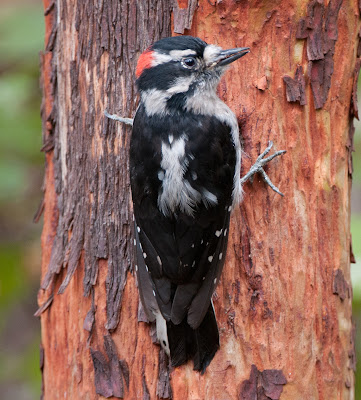I was prepared to post more photos from New Mexico (I've finally moved beyond the Bosque del Apache in my processing!) but I spent some time in the yard today and had a new yard bird, so it's back to the Pacific Northwest. Several days ago I took a nice photo of what I understand is an Eastern Gray squirrel so it's up first. I have four or five which frequent the yard and they really need to go... you can have one or more FREE!
Today began overcast and not at all auspicious for bird photography. However in looking out the kitchen window a little after noon I noted that there were probably 20 birds in our watercourse so I thought I would indulge myself in a little photography. I dutifully filled the feeders and cleaned the bird baths. By the time I had finished the chores it had begun to sprinkle but I hadn’t gotten out with my camera yet. After just a few minutes it stopped so I sat on our bench to see what the weather was going to do. It didn’t take long for the day to get interesting.
After being outside for only a few minutes all three of our woodpeckers showed up… a pair of Northern flickers, a male Hairy and a male Downy. It didn’t take the Hairy and Downy long to get into it. It matters not that there are multiple feeders and bird baths in the yard. In nature they are competing for the same food sources so there is almost always friction between them. The Downy was trying to get a drink from one of the bird baths when the Hairy decided it was time to intercede. It flew to a couple of feet above the bird bath and I then noticed that the Downy woodpecker had apparently disappeared. Then I spied it hanging upside down on the bottom side of a one-inch staging stick I have by the bird bath. It had fooled me but not the Hairy woodpecker. The Hairy woodpecker ran it off. Unfortunately I was waiting on the weather and still hadn’t brought my camera outside.
I retrieved my camera and positioned myself where I have a photographic corridor of two bird baths, several staging areas near the feeders and most of our watercourse. There were lots of birds in the yard but most of them were House sparrows.
Both Black-capped chickadees and Chestnut-backed chickadees were in and around the yard as well as Red-breasted nuthatches. I also had House finches and American goldfinches, many of which were this year’s production.
After a while my attention was drawn to a bird that quickly flitted into the yard. I only got a brief glimpse at first and thought that it might be a Mountain chickadee (which I am still waiting to see here) but when I got a better look I realized that it was a warbler. It flew rather directly to the upper pool of the watercourse and I had a good view so I started taking photos. I probably took about a dozen photos in all and kept most of them. It was very difficult to keep in sight as it was rather easily confused with the Black-capped chickadees and I soon lost track of it. I went and got a bird book and discovered that it was a Black-throated Gray warbler… a new species for the yard! It made a fleeting return about a half-hour later but gave me no opportunity for additional photos.
While I was in the yard we were visited by a Bewick’s wren, a bird my wife has seen several times in the past week or so but an unusual visitor to the yard.
We also had another relatively rare visitor for this time of year… a female Red-winged blackbird which visited one of the sunflower feeders. It’s fairly common to have the males and females visit the feeder during the breeding season but I haven’t seen one for at least two months. My theory is that during the breeding season both parents are busy defending their territories and nests and they want to spend a minimal amount of time away from the nest and hunting for food. The city’s waste-water treatment plant is down the hill from us and there is a sizable marsh where the birds nest. They make direct, rapid trips up the hill to get the quick, easy food and then rush back to defend the nests.
We also had what has become a daily occurrence… a sighting of our resident parakeet which has established itself in our trees for the past couple of months. At times I’ve been able to get quite close to the bird but on other occasions it’s quite skittish. We tried various ways of capturing the bird with no success, so it appears that it will be on its own for the winter. I finally obtained a couple of decent photos of the bird this afternoon when it joined the sparrows to eat seed off of the ground.
Finally, I photographed this American robin with an interested observer...
Other visitors: European starlings, Rock pigeons, a female Anna’s hummingbird (and a male just before dark), a Belted kingfisher flying high overhead and crows.


























 It
It






